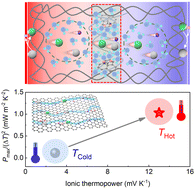Remarkable high-temperature ionic thermoelectric performance induced by graphene in gel thermocells†
Abstract
Gel thermocells employing redox couple ions as carriers can convert heat into electricity, playing an important role in low-grade heat harvesting. However, a major challenge is maintaining the high ionic thermoelectric performance at non-room temperatures due to the limited heat tolerance of gels. Herein, we propose an effective strategy to improve both ionic thermopower and output power density at high temperatures by optimizing the gel composition via introducing graphene. Graphene forming a structure like a “bridge” could improve the ion diffusion coefficient and exchange current density, thereby improving performance. A high ionic thermopower of up to 13 mV K−1, an output power density of 1.03 mW m−2 K−2, and a continuous discharge energy density of 0.19 J m−2 K−2 in 1 h were obtained at 323 K in gels of Gelatin-0.04/0.06 M FeCN4−/3−-6 wt% Gr. In addition, a record-high output power density of 1.2 mW m−2 K−2 was delivered at 323 K in a device assembled by four gel thermocells in series. This work provides an achievable guide for fabricating and designing high-performance gels to harvest low-grade heat, especially at high operating temperatures.



 Please wait while we load your content...
Please wait while we load your content...